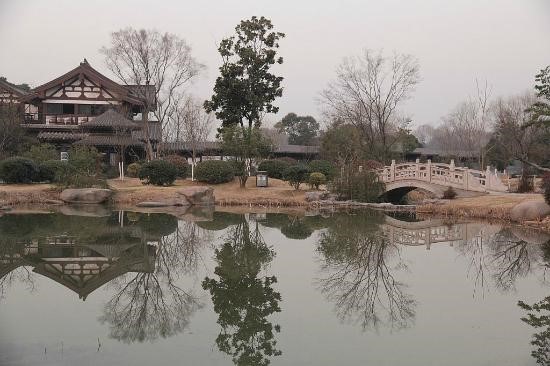NIUJIE (“OXEN”) STREET in Beijing is home to a long-standing ethnic Muslim community. Visitors will find mosques in which to pray and many halal restaurants in which to eat. The aroma of mutton hotpot and other Islamic dishes drifts over the area.
In the late 13th century, 60 years after the mighty cavalry led by Genghis Khan occupied almost the whole of Asia, Emperor Kublai established the Yuan (元) Empire ,and settled the capital in what is now called Beijing. Then the name of the capital was Dadu (大都), which means “A city of Khan” in Mongolian. During many years of warring, many Muslims born in Central Asia married local Han (漢) people and finally settled in this land. In this way, a new ethnic group, the “Hui” (回族), came into being.

Just like their Arabian ancestors, the Hui people followed similar lifestyles and customs. For the convenience of worship, Hui communities preferred to live around a mosque. The Oxen Street Mosque ,named after its location, was built in the Liao Dynasty (遼代), before the founding of the Yuan Empire. Four hundred years later, the mosque was reconstructed as well as enlarged under the Kangxi Emperor (康熙皇帝1661–1722) of the Qing Dynasty(清朝), to strengthen the bond between the Hui people and the main ethnic groups.

MOSQUES IN BEIJING
As one of the most important and historical mosques in northern China, the Oxen Street Mosque covers an area of approximately 10,000 square meters. The mosque created a perfect combination of Islamic and Han Chinese cultural and architectural features. From the outside, its architecture shows traditional Chinese influence and the inside has a blend of Islamic calligraphy and Chinese design.

The main prayer hall is 600 square meters in area and can hold more than 1,000 worshipers. Built out of timber, the mosque is also home to some important cultural relics and tablets such as the upright tablet of an emperor’s decree proclaimed in 1694 during the Qing Dynasty, showing the Chinese characters “敕賜禮拜寺”, which means “a mosque approved by the Emperor”. The words are said to have been written by Emperor Kangxi himself.

HOME TO CUISINE EXPERT
In the relatively recent Qing Dynasty, the Hui community located in the capital had already been renowned for delicious preparation of beef. To this day, there is saying in the Hui community: “If two knives are held in a Hui person’s hand, one is cutting mutton, the other rice cake.” Hui people tended to earn their livings selling either mutton or rice cake.

Ding Deshan (丁德山), an expert in cooking mutton, was one of the Hui people from Oxen Street. In Beijing in 1903, Ding started his business in the eastern downtown area. In the very beginning, he could just manage to sell mutton noodles and soba cake. Every early morning after the first crow of the cockerel, Ding carried all his tools, including wooden boards, pots and knives, in a small cart.
He and his brother just stood behind their food stand, shouting to attract more customers. After a few years’ effort, they saved up some money to set up a porridge shop at the same place. Meanwhile, the specialities increased to mutton pie, meat porridge and meat soup, and it all got a warm welcome from local people. Unfortunately, the eastern downtown area was burned down in an accident. Ding’s porridge shop did not survive.
But they did not give up. After the re-establishment of the eastern downtown district, Ding bought a bigger store and invested all of his savings into it.
MUTTON FEAST
His restaurant “Donglaishun” (東來順) officially opened in 1912, mainly selling instant-boiled lamb. Ding was a man good at managing the operation. He had a series of strict standards for selecting lamb. He only chose two-or-three-year-old castrated sheep as raw material. Apart from hind legs, tail, and fillets, the other parts of a sheep were not cooked. This meant that a sheep of 40 to 50 kilograms weight only had 13 kilograms’ meat on it that could be used.

Besides, a one-kilogram lamb should be sliced into 160 pieces at least. Covering the blue and white porcelain plate with paper-thin meat slices, the patterns on the dishes would still be clearly visible.

Today, you can still see customers sitting around a hot pot in Donglaishun restaurant, picking up a thin lamb slice into the boiling water, counting to just three, and then dipping it into the small plate with sauce in front of themselves: what a pleasant feast in Beijing!
Image at the top by Kunal Kalra
